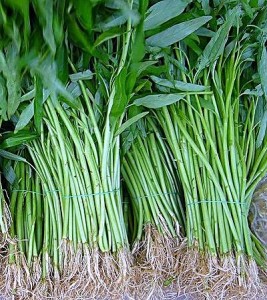 Ipomoea aquatica is a semi-aquatic tropical plant grown as a leaf vegetable. It is known in English as Water Spinach, Water Morning Glory, Water Convolvulus, or by the more ambiguous names “Chinese spinach” and “swamp cabbage”. It is found throughout the tropical and subtropical regions of the world; it is not known exactly where it originated.
Ipomoea aquatica is a semi-aquatic tropical plant grown as a leaf vegetable. It is known in English as Water Spinach, Water Morning Glory, Water Convolvulus, or by the more ambiguous names “Chinese spinach” and “swamp cabbage”. It is found throughout the tropical and subtropical regions of the world; it is not known exactly where it originated.
Kang kong prefers damp conditions, flourishing along the banks of streams and boggy areas. The plant’s long, hollow, pale-green stems float on the water or creep along damp ground. The leaves are darker green and are usually long to heart-shaped, depending on variety. Unlike some other green vegetables, kang kong is not bitter; it has a sweet, mild flavor. The young shoots and leaves are picked before the plant flowers to ensure good quality.
In the Philippines, it is popularly known as “Kangkong”. Farmers grow it as a regular crop in lowland rice fields, and it is the most economical vegetable to grow. It requires less labor since it does not need careful land preparation or watering.
Kangkong is usually sautéed in cooking oil, onions, garlic, vinegar, and soy sauce. This dish is called adobong kangkong. Kangkong is also a common leaf vegetable in fish and meat stews like sinigang. There is also an appetizer called crispy kangkong, where fresh leaves are mixed with eggs, water, cornstarch, flour, salt and pepper. The leaves are fried until crispy and golden brown.
Also found in the leafy vegetable are minerals and vitamins like calcium, phosphorus, sodium, potassium, vitamin A, thiamine, riboflavin, niacin, and ascorbic acid. Because of its high iron content, the vegetable is recommended to patients suffering from anemia.
How to grow Kangkong
Varieties:
- Lunting Pangako – broad leaves
- Pinchit – broad leaves
- Kangkong Tsina – narrow leaves
- Chinese Upland – narrow leaves
Climatic And Soil Requirements
Upland kangkong can be grown from low to mid elevations throughout the year. Production is best in sandy to clay loam soil with a pH of 5.5-6.5.
Land Preparation
Prepare land by plowing and harrowing twice. Prepare raised beds 1 m wide. Spread well-decomposed animal manure at the rate of 1-2 kg/m2
between beds. Make shallow lines 10 cm apart across the beds before sowing.
Propagation and Planting
Kangkong can be grown in garden plots and containers. Sow seeds directly in rows or space evenly in containers. Seeds and cuttings are used for propagation. Plant densities may vary between 30-170 plants/m2.
Fertilization
Apply 1-2 kg/m2 animal manure before sowing. Ten to fifteen days later, top dress with urea (46-0-0) or ammonium sulfate (21-0-0).
Irrigation
Water the plants everyday or as needed. Mulch with rice straw or rice hull to cut watering by at least 50%.
Pests and Disease Management
Caterpillars, whiteflies and aphids cause serious damage. Control by regular pruning of stems. Spray the plants with hot pepper extract or insecticidal soap to get rid of aphids. Regular pruning at three weeks interval can minimize white rust.
Harvesting
Harvest by cutting young shoots 20-50 days after sowing and subsequently at regular intervals. The plants are cut about 5-10 cm above ground. Uprooting can also be practiced at 20-30 days after sowing.
Seed Production
Upland kangkong flowers in October and seeds start to mature from March to April. For small-scale production, harvest dried or mature fruits individually. Sun-dry until the husk is brittle enough for seed extraction. Each fruit contains 3-4 seeds.
For large-scale seed production, harvest the entire plant when majority of the fruits are mature. Sundry for 3-5 days and thresh in the rice thresher. The hay or refuse may be fed to the thresher several times to maximize seeds yield. Dry extracted seeds to about 10-11% moisture content. Winnow to remove debris and poor quality seeds. Pack in moisture-proof containers. Label and store in a cool, dry place. There is no need to treat kangkong seeds with pesticides.
Sources: www.darfu4b.da.gov.ph; Photo: Wikipedia.org